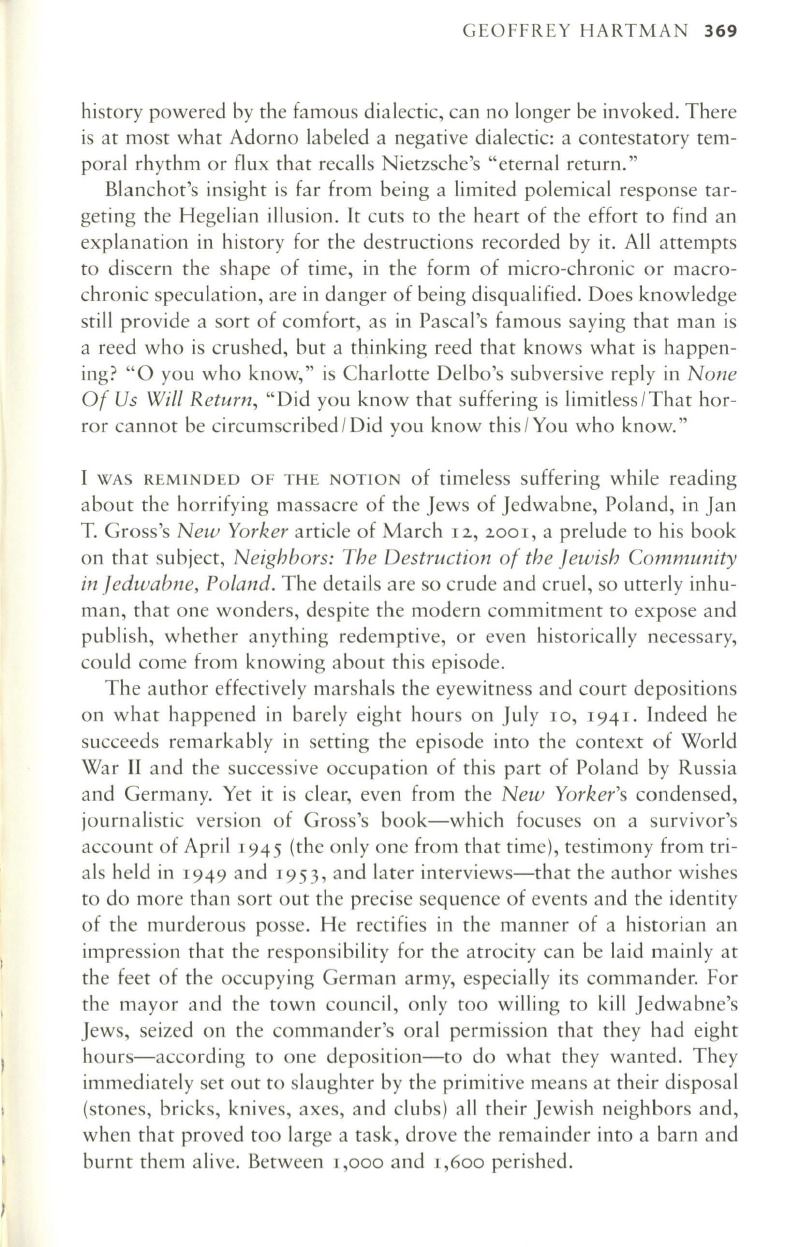
GEOFFREY HARTMAN
369
history powered by the famous dialectic, can no longer be invoked. There
is at most what Adorno labeled a negative dialectic: a contestatory tem–
poral rhythm or flux that recalls Nietzsche's "eternal return."
Blanchot's insight is far from being a limited polemical response tar–
geting the Hegelian illusion.
It
cuts to the heart of the effort to find an
explanation in history for the destructions recorded by it. All attempts
to discern the shape of time, in the form of micro-chronic or macro–
chronic speculation, are in danger of being disqualified. Does knowledge
still provide a sort of comfort, as in Pascal's famous saying that man is
a reed who is crushed, but a thinking reed that knows what is happen–
ing? "0 you who know," is Charlotte Delbo's subversive reply in
None
Of Us Will Return,
"Did you know that suffering is limitless /That hor–
ror cannot be circumscribed /Did you know this /You who know."
I
WAS REMINDED OF THE NOTION
of timeless suffering while reading
about the horrifying massacre of the Jews of Jedwabne, Poland, in Jan
T. Gross's
New Yorker
article of March
12, 2001,
a prelude to his book
on that subject,
Neighbors: The Destruction of the Jewish Community
in Jedwabne, Poland.
The details are so crude and cruel, so utterly inhu–
man, that one wonders, despite the modern commitment to expose and
publish, whether anything redemptive, or even historically necessary,
could come from knowing about this episode.
The author effectively marshals the eyewitness and court depositions
on what happened in barely eight hours on July
10, 194I.
Indeed he
succeeds remarkably in setting the episode into the context of World
War II and the successive occupation of this part of Poland by Russia
and Germany. Yet it is clear, even from the
New Yorker's
condensed,
journalistic version of Gross's book-which focuses on a survivor's
account of April
1945
(the only one from that time), testimony from tri–
als held in
1949
and
1953,
and later interviews-that the author wishes
to do more than sort out the precise sequence of events and the identity
of the murderous posse. He rectifies in the manner of a historian an
impression that the responsibility for the atrocity can be laid mainly at
the feet of the occupying German army, especially its commander. For
the mayor and the town council, only too willing to kill Jedwabne's
Jews, seized on the commander's oral permission that they had eight
hours-according to one deposition-to do what they wanted. They
immediately set out to slaughter by the primitive means at their disposal
(stones, bricks, knives, axes, and clubs) all their Jewish neighbors and,
when that proved too large a task, drove the remainder into a barn and
burnt them alive. Between
1,000
and
1,600
perished.


